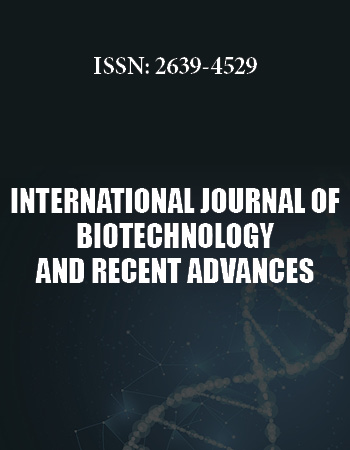Research Article
Effect of Extra Supplementation of Methionine and Threonine on Growth Performance and Immune Response in Broilers
1 Institute of Animal and Dairy Sciences, University of Agriculture, Faisalabad, Pakistan
2Evonik (SEA) Pte. Ltd, 609927, Singapore
*Corresponding author: Muhammad Umar Yaqoob, Institute of Animal and Dairy Science, University of Agriculture, Faisalabad, Pakistan, E-mail: yaqoobmumar@gmail.com
Received: April 30, 2018 Accepted: May 25, 2018 Published: May 30, 2018
Citation: Yaqoob MU, Ali M, Abiden MZ, Sharif M, Raza SH. Effect of Extra Supplementation of Methionine and Threonine on Growth Performance and Immune Response in Broilers. Int J Biotechnol Recent Adv. 2018; 1(1): 1-5. doi: 10.18689/ijbr-1000101
Copyright: © 2018 The Author(s). This work is licensed under a Creative Commons Attribution 4.0 International License, which permits unrestricted use, distribution, and reproduction in any medium, provided the original work is properly cited.
Abstract
Extra supplementation of amino acids is considered to be good for better immune response in broilers. The aim of present study was to investigate the effect of extra supplementation of methionine (Met) and threonine (Thr) on growth performance, carcass characteristics and immune response in broilers. Three hundred day-old boiler chicks (mixed sex) were distributed into five experimental groups with six replicates (10 chicks/replicate) in each group. Five (A, B, C, D and E) iso-caloric (ME 2850 kcal/kg) starter and five (A, B, C, D and E) iso-caloric (ME 2950 kcal/kg) finisher diets were formulated. Diet A was standard commercial diet with 100% NRC amino acids recommendations whereas diets B, C, D and E contained 110% methionine + cysteine (M+C) level, 120% M+C level, 110% threonine (Thr) and 120% Thr, respectively. Results showed that the feed inatke, weight gain and feed conversion ratio were found non-significant (P<0.05) between the treatment groups. Breast meat yield was improved (P<0.05) in chicken fed diets (B, C, D and E) with extra supplementation of Met and Thr. Highest (P<0.001) haemaglutination inhibition titer level against Newcastle disease was found in chicks (6.50) fed diet E after first vaccination and in chicks fed diet B (5.50) after second vaccination. Similarly, higher weight (5.00g) of bursa of fabricius was also found in chicks fed diet B. The ELISA titer level against infectious bursal disease was not affected (P>0.05) by dietary treatments. It is concluded that supplementation of Met and Thr above the recommended levels improve breast meat yield and immune response in chicks. However, it is not economical to do extra supplementation of Met and Thr in broiler diet in terms of growth performance.
Keywords: Methionine+Cystine, threonine, growth performance, immune response, broilers
Introduction
Amino acids are the constituents of proteins and essential for proper immune function. Deficiency of amino acids can lead to less growth performance and stress on the immune system [29]. The stress on immune system means that chicks are more susceptible to diseases. Methionine (Met) is a sulfur-containing first limiting amino acid in poultry diets with multifunctional properties. Met has the property to convert into other amino acids through transamination. It is assumed that Met supplementation can fulfil the deficiency of nutritionally non-essential amino acids [8] Met increases the feed conversion ratio (FCR), breast meat yield and dressing percentage in broilers. It works as contributor of methyl group which is used in the methylation of DNA and protein so it is involved in the gene expression [3].
Glutathione (GSH) protects the cells from free radicals e.g. hydroxyl radicals, lipid peroxide radicals and H2O2 [21]. Met influences the synthesis of the GSH in the cell. It is proved that GSH plays a salient role in the acclimatization of metabolic pathway related to immunological challenges. Furthermore, antibody production in the body and T-helper cell functioning also regulated by intensification of GSH in antigen-processing cells. Thus, intracellular GSH and concentration of CD4 cells (a type of glycoprotein found on the surface of immune cells) decline by the inadequate amount of sulphur containing amino acids. It is used for signalling the other immune cells in response to infection. It also has a function in lymphocyte proliferation and increase antibody production and its deficiency leads to reduction in the propagation of lymphocytes and reduce cytotoxic T-cell activity [21]. Dietary supplementation of Met has been proved beneficial for broilers to strengthen their immune system against Newcastle virus through IgG secretion, T-cell proliferation, antibody titre and leucocyte migration [34]. Supplementary Met enhanced the response to total antibody production against SRBC a T-dependent antigen [34]. Met level required to adjust leukocyte migration inhibition was higher than the level required to enhance the growth performance in broilers chicks [9]. However, using a purified diet, Met need appeared higher for growth than for humoral immunity [6].
Threonine (Thr) is also very important for immune functions because it is involved in synthesis of mucin plasma γ-globulin in chicks. Thr is required for proper gastrointestinal and immune functioning of the broilers [11], because it is required for the synthesis of mucin [23]. Mucin is essential protein for proper intestinal immunity [21,19]. Any modification in the production of mucin can impair the function of gut protection and absorption [15]. On the basis of these findings, it can be hypothesized that Thr actively involved in modulating immune function. To reduce the economic loss in terms of mortality and morbidity in broilers and to lower down the use of antibiotics, it is hypothesized that amino acids will extensively become economical nutraceuticals for amelioration of health and restraining of contagious diseases in broilers. Animal feeding trails showed that different components of immune system showed different response at varying dietary levels of Thr [20]. Similarly, antibody titres levels increase in chickens by increasing dietary Thr levels infected with the Newcastle disease virus [7] Also, dietary supplementation with Thr increased serum levels of IgG in sows [17]. These findings provide support for a role of dietary threonine in modulating immune function in livestock and perhaps humans. There is discrepancy in the literature on extra supplementation of Met and Thr in broiler diet for immune response. Therefore, present study was designed to determine the effect of higher dietary levels of methionine+cysteine (M+C) and Thr in broiler diet on growth performance (feed intake, weight gain and FCR), carcass parameters (dressing percentage and breast meat yield) and immune response against Newcastle disease and infectious bursal disease.
Materials and Methods
Chicks and experimental diets
Three hundred day-old boiler chicks (mixed) of Hubbard strain were distributed into five experimental groups with six replicates (10 chicks/replicate) in each group. Fresh clean water and feed were provided ad libitum around the clock. Five (A, B, C, D and E) iso-caloric (ME 2850 Kcal/kg) starter and five (A, B, C, D and E) iso-caloric (ME 2950 Kcal/kg) finisher diets were formulated. Diet A was control diet with 100% amino acids according to NRC recommendations [25] whereas diets B, C, D and E contained 110% M+C, 120% M+C, 110% Thr and 120% Thr, respectively. Starter and finisher diets were fed from 1-21 and 22-35 days, respectively. Ingredient and nutrient composition of starter and finisher diets are presented in Tables 1 and 2.
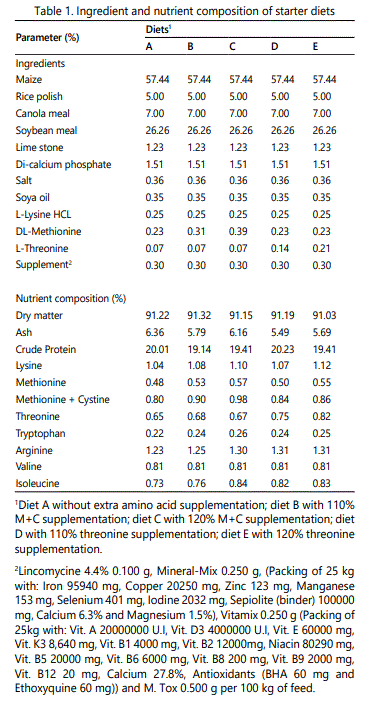
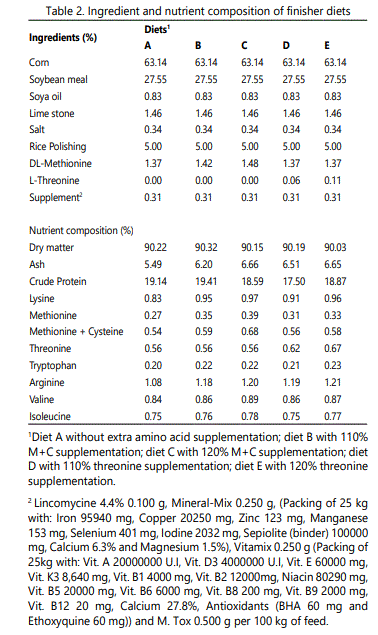
Data collection
Feed intake and weight gain were recorded weakly and used to calculate FCR. All chicks were vaccinated against Newcastle disease virus (NDV) on day 5 and 28 and Infectious Bursal disease virus (IBDV) on day 15 and 22, by using live vaccines. Blood samples were collected seven days after every vaccine from randomly selected six chicks per group. To check the maternal anti bodies level against IBDV, blood samples was taken before the vaccination against IBDV. Blood serum was separated by centrifugation of blood. Haemagglutination inhibition (HI) test was performed to check antibody titer level against NDV [2]. To check immunity against IBDV, ELISA was performed using IDEXX USA Elisa kit. All blood sera were analysed at Veterinary Diagnostic Laboratory, Department of Pathology, University of Agriculture Faisalabad, Pakistan. Weight of different lymphoid organs (thymus gland, spleen and bursa of Fabricius) of slaughtered chicks was also recorded. For this purpose six chicks from each group were slaughtered at 35th day of experiment. Dressing % and breast meat yield was also recorded.
Chemical analysis
Feed samples were analysed for dry matter (DM), ash and crude protein (CP). Feed samples were oven dried at 105° C for 4h and ash was determined by incinerating the weighted amount of feed in furnace at 550° C for 6 h. The nitrogen (N) was determined by Kjeldhal method and CP was calculated as N×6.25 [4].
Economics
Cost of all the experimental diets was calculated. Feeding cost per kg live weight gain was calculated to compare the economics.
Statistical analysis
Data collected for each parameter were analysed using PROC GLM procedure of Statistical Analysis System [30]. The means were compared using Tukey’s test [32] and the differences were checked for statistical significance (P<0.05).
Results
Growth Performance
Table 3 shows data on feed intake, weight gain, feed conversion ratio, dressing % and breast meat yield of chicks fed different experimental diets. Feed intake, weight gain and feed conversion ration were found non-significant (P>0.05) between the experimental groups. Highest weight gain (1735.60g) was observed in chicks fed diet C. The FCR was same (1.69) for chicks fed diets A (control) and E. Non-significant (P>0.05) effect of extra methionine and threonine supplementation was found on dressing percentage. Breast meat yield was high in broilers fed on diet C, D or E.

Immune response
Data on immune response of broilers fed experimental diets is given in Table 4. Highest (P<0.001) HI titer level against NDV was observed in group E (6.50) and B (5.50) after first and second vaccination, respectively. However, Elisa titer level against IBDV was not different (P>0.05) within treatment groups. Weight of bursa of fabricius was effected (P<0.05) by feeding different levels of methionine and threonine. Highest weight (5.0g) was found in group B, the weight of other immune organs was not affected (P>0.05) by dietary treatments.
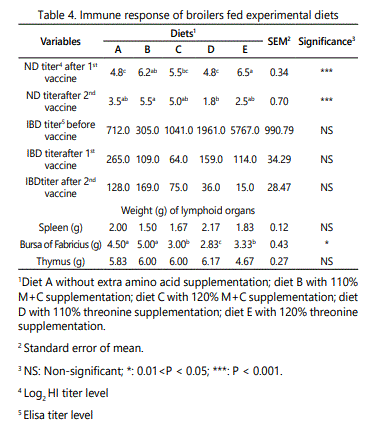
Economics
Table 5 shows the economics of different experimental diets in terms of feed cost per kg weight gain. Feed cost/ kg weight gain was not effected (P>0.05) by using higher levels of methionine and threonine in diet.
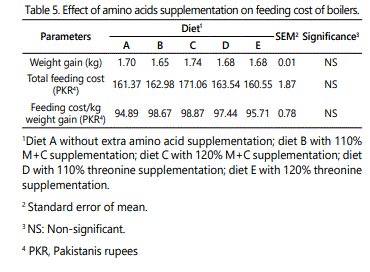
Discussion
Amino acids are the essential component of broilers diet. They not only involve in muscle accretion but also play many other important roles i.e. improve the development of lymphoid organs [17], as an anti-oxidant [31] and maintain the intestinal integrity [21]. Supplementation of amino acids over the top of recommended levels can improve the homogeneity of flock which has important economic impact at the slaughter level [9] In the present study, growth performance of chicks fed different high levels of M+C (110 and 120%) and Thr (110 and 120%) diets was found non-significant (P>0.05). [33] also found nonsignificant difference in feed intake and FCR for extra methionine supplementation. [1] reported that the FCR was improved (P<0.05) by Thr supplementation (at least 110% recommended level of Ross), however it tended to improve it throughout the research period due to significant increase (P<0.05) in body weight gain.Dressing percentage was also not improved significantly (P>0.05) by supplementation of amino acids as results were obtained by other experiments [1,16,28,22] Results of different studies on Met [24,14] and Thr supplementation [13,27,26,11] showed non-significant (P<0.05) improvement in dressing percentage and breast meat yield. Breast meat yield was improved (P<0.05) by amino acids supplementation but it was same (P>0.05) for higher levels of Thr (110 and 120%) and higher level of Met (120%). [1] also reported that Thr supplementation increased (P<0.05) the relative weight of breast. In this regards other studies [16,10,12,11] also confirm our fining that supplementation of Thr significantly increase breast meat yield. In the present study, the HI antibody titer level against NDV, after first and second ND vaccine was found significant (P<0.001) within the groups. Highest HI titer level after first vaccine was observed in serum collected from the bird fed 120% Thr supplemented diet. Similar trend in HI titer was observed by Bhargava [1,6] reported that Thr supplementation enhanced immune response in broilers. [20] also observed that the immune system is affected by level of Thr in diet. Dietary Thr strengthens the immune system in broilers [21,35]. In the present study, the HI antibody titer after second vaccination was found highest in serum collected for broilers of group B fed diet supplemented with 110% M+C. Similar trend in HI antibody titer after second vaccine was observed by Bhargava [7] But in another study Bhargava [6] found that inverse relationship exists between supplementation of Met and HI titer to NDV in chicks immunized at day 4. In the present study, antibody titer level against IBDV was not affected (P>0.05) by extra supplementation of Met and Thr. Among the lymphoid organs, the weight of Bursa was higher for experimental diet B (110% M+C) but the weight of spleen and thymus was not affected (P>0.05). These results are in agreement with those of Kidd [18] who reported that no effect of dietary threonine on the development of immune organs in young broilers.
Conclusions
From results of present study, it is concluded that breast meat yield and immunity of broilers improved by feeding high level of Met (10% more than NRC recommendations) and Thr (20%more than NRC recommendations). However the growth performance and economics are not affected by supplementing high levels of methionine and threonine.
Acknowledgement
The authors acknowledge the financial support by EVONIK. The authors are also thankful for laboratory staff of Institute of Animal Science for technical assistance during chemical analysis.
Refrences
- Abbasi MA, Mahdavi AH, Samie AH, Jahanian R. Effects of different levels of dietary crude protein and threonine on performance, humoral immune responses and intestinal morphology of broiler chicks. Rev. Bras. Cienc. Avic. 2014; 16: 35-44. doi: 10.1590/S1516-635X2014000100005
- Allan WH, Lancaster JE, B Toth. Newcastle disease vaccines: Their production and use. FAO of the United Nations. Animal Production and Health Series. 1978.
- Anderson OS, Sant KE, Dolinoy DC. Nutrition and epigenetics: an interplay of dietary methyl donors, one-carbon metabolism and DNA methylation. J. Nutr. Biochem. 2012; 23: 853-859. doi: 10.1016/j.jnutbio.2012.03.003
- AOAC. Official Methods of Analysis. 17th Ed. Inc., 2000. Maryland, U.S.A
- Bhargava KK, Hanson RP, Sunde ML. Effects of methionine and valine on antibody production in chicks infected with Newcastle disease virus. J. Nutr. 1970; 100: 241-248. doi: 10.1093/jn/100.2.241
- Bhargava KK, Hanson RP, Sunde ML. Effects of threonine on growth and antibody production in chicks infected with Newcastle disease virus. Poult. Sci. 1971; 50: 710-713. doi: 10.3382/ps.0500710
- Bhargava KK, Hanson RP, Sunde ML. Effects of methionine and Valine on growth and antibody production in chicks infected with live or killed Newcastle disease virus. Poult. Sci. 1971; 50: 614-619. doi: 10.3382/ps.0500614
- Bunchasak C, Using synthetic amino acids in broiler chicken diet. Animal Science Congress. 2008; 7-18.
- Corzo A, McDaniel CD, Kidd MT, Miller ER, Boren BB, Ancher BIF, et al . Impact of dietary amino acid concentration on growth, carcass yield, and uniformity of broilers. Austr. J. Agric. Res. 2004; 55: 1133-1138. doi: 10.1071/AR04122
- Ciftci I, Ceylan N. Effects of dietary threonine and crude protein on growth performance, carcase and meat composition of broiler chickens. Brit. Poult. Sci. 2004; 45: 280-289. doi: 10.1080/00071660410001715894
- Dozier WA, Moran ET, Kidd MT. Comparisons of male and female broiler responses to dietary threonine from 42 to 56 days of age. J. Appl. Poult. Res. 2001; 10: 53-59. doi: 10.1093/japr/10.1.53
- Dozier WA, Moran ET, Kidd MT. Threonine requirement of broiler males from 42 to 56 days in a summer environment. J. Appl. Poult. Res. 2000; 9: 496-500. doi: 10.1093/japr/9.4.496
- Everett DL, Corzo A, Dozier WA, Tillman PB, Kidd MT, et al. Lysine and threonine responses in Ross TP16 male broilers. J. Appl. Poult. Res. 2010; 19: 321-326. doi: 10.3382/japr.2010-00152
- Halder G, Roy B. Effect of herbal or synthetic methionine on performance, cost benefit ratio, meat and feather quality of broiler chicken. Int. J. Agri. Res. 2007; 2: 987-996. doi: 10.3923/ijar.2007.987.996
- Horn NL, Donkin SS, Applegate TJ, Adeola O. Intestinal mucin dynamics: Response of broiler chicks and White Pekin ducklings to dietary threonine. Poult. Sci. 2009; 88: 1906-1914. doi: 10.3382/ps.2009-00009
- Jahanian R, Effects of dietary threonine on performance and immunocompetence of starting broiler chicks. 2nd International Veterinary Poultry Congress. Tehran. Iran. 2010; 200.
- Kidd MT. Nutritional modulation of immune function in broilers. Poult. Sci. 2004; 83: 650-657. doi: 10.1093/ps/83.4.650
- Kidd MT, Gerard PD, Heger J, Kerr BJ, Rowe D, et al. Threonine and crude protein responses in broiler chicks. Anim. Feed Sci. Tech. 2001; 94: 57-64. doi: 10.1016/S0377-8401(01)00301-7
- Kim SW, Mateo RD, Yin YL, Wu G. Functional amino acids and fatty acids for enhancing production performance of sows and piglets. Asian-Aust J. Anim. Sci. 2007; 20: 295-306.
- Li DF, Xiao CT, Qiao SY, Zhang JH, Johnson EW, et al. Effects of dietary threonine on performance, plasma parameters and immune function of growing pigs. Anim. Feed Sci. Tech. 1999; 78: 179-188. doi: 10.1016/S0377-8401(99)00005-X
- Li P, Yin YL, Li D, Kim SW,Wu G. Amino acids and immune function. Brit. J. Nutr. 2007; 98: 237-252. doi: 10.1017/S000711450769936X
- Mack S, Bercovici D, De Groote G, Leclercq B, Lippens M, et al. Ideal amino acid profile and dietary lysine specification for broiler chickens of 20 to 40 days of age. Brit. Poult. Sci. 1999; 40: 257-265. doi: 10.1080/00071669987683
- Montagne L, Piel C, Lalles JP. Effect of diet on mucin kinetics and composition: Nutrition and health implications. Nutr. Rev. 2004; 62: 105-114. doi: 10.1111/j.1753-4887.2004.tb00031.x
- Mukhtar MA, Mohammed KA, Musa MH. Replacement value of lysine and methionine for super concentrate in broiler chicks yield and quality. J. Sci. Tech. 2010; 11: 28-29.
- National Research Council. Nutrient Requirements of Poultry. 9th Rev. Edition. Natl. Acad. Pres, Washington, 1994.
- Ojano-Dirain CP, Waldroup PW. Evaluation of lysine, methionine and threonine needs of broilers three to six weeks of age under temperature stress. Int. J. Poult. Sci. 2002; 1: 16-21.
- Rezaeipour V, Fononi H, Irani M. Effects of dietary L-threonine and Saccharomyces cerevisiae on performance, intestinal morphology and immune response of broiler chickens S. Afr. J. Anim. Sci. 2012; 42: 266-273. doi: 10.4314/sajas.v42i3.8
- Rosa AP, Pesti GM, Edwards HM, Bakalli RI. Threonine requirements of different broiler genotypes. Poult. Sci. 2001; 80: 1710-1717. doi: 10.1093/ps/80.12.1710
- Rubin LL, Canal CW, Ribeiro ALM, Kessler A, Silva I, et al. Effects of methionine and arginine dietary levels on the immunity of broiler chickens submitted to immunological stimuli. Rev. Bras. Cienc. Avic. 2007; 9: 241-247. doi: 10.1590/S1516-635X2007000400006
- SAS. User’s Guide Statistics, Version 9.2 Edition, SAS Inst., Inc., Cary, NC. 2009.
- Stadman, ER, Van Remmen A, Richardson, Wher NB, Levine RL, et al. Methionine oxidation and aging. Bioch. Biophys. Acta. 2005; 1703: 135-140. doi: 10.1016/j.bbapap.2004.08.010
- Steel, RGD, Torrie JH, Dickey A. Principles and Procedures of statistics. A biometric approach 3rd ad. McGraw hill book Co. Inc. New York. USA. 666. 1997.
- Swain BK, Johri TS. Effect of supplemental methionine, choline and their combinations on the performance and immune response of broilers. Brit. Poult. Sci. 2000; 41:83-88. doi: 10.1080/00071660086457
- Tsiagbe VK, Cook ME, Harper AE, Sunde ML. Efficacy of cysteine in replacing methionine in the immune responses of broiler chicks. Poult. Sci. 1987; 66: 1138-1146. doi: 10.3382/ps.0661138
- Wang X, Qiao SY, Liu M, Ma YX. Effects of graded levels of true ileal digestible threonine on performance, serum parameters and immune function of 10–25 kg pigs. Anim. Feed Sci. Tech. 2006; 129: 264-278. doi: 10.1016/j.anifeedsci.2006.01.003

